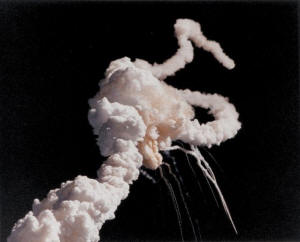|
 Challenger
accident shapes new wave of passenger spaceships Challenger
accident shapes new wave of passenger spaceships
 Send a link to a friend
Send a link to a friend
[January 28, 2016]
By Irene Klotz
CAPE CANAVERAL, Fla. (Reuters) - Thirty
years after the space shuttle Challenger exploded during liftoff, a new
generation of spaceships continues to build on changes made after NASA's
fatal accident.
|
|
 Challenger blasted off from the Kennedy Space Center in Florida on
the frigid morning of Jan. 28, 1986. The flight lasted just 73
seconds after a rubber seal in one of the shuttle’s twin booster
rockets failed, triggering an explosion. Challenger blasted off from the Kennedy Space Center in Florida on
the frigid morning of Jan. 28, 1986. The flight lasted just 73
seconds after a rubber seal in one of the shuttle’s twin booster
rockets failed, triggering an explosion.
The disaster exposed shuttle design shortcomings and operational
problems in the U.S. space program. But it also helped seed a
commercial space transportation industry that is now developing
passenger spaceships.
Accident investigators also found that pressure to maintain a busy
flight schedule contributed to Challenger's demise. At the time,
NASA’s four-ship shuttle fleet, flying several times a month, was
the nation’s sole space transportation system.
After the accident, then-President Ronald Reagan banned commercial
satellites from the shuttles and bolstered military efforts to
develop alternative launchers.
 The policy shift laid the groundwork for today's commercial space
transportation industry, which generated global revenues of $5.9
billion in 2014, according to a report last year by the Satellite
Industry Association.
Accidents remain inevitable as the field matures, said Mike
Leinbach, a former NASA shuttle launch director.
“Spaceflight is like any other big engineering system," he said,
noting that cruise ships and aircraft became safer after accidents.
"You get smart by successes. You get smart by failures. ... It’s an
evolution.”
Six astronauts and a high school teacher flying aboard Challenger
had no chance of escaping due to a spacecraft design decision, which
is not being repeated on the passenger spaceships now under
development.
[to top of second column] |

These will launch on top of rockets, not alongside them, and have
separate systems to fly crews to safety if a booster falters.
The Challenger accident also exposed NASA management problems. For
example, the night before launch, engineers warned that freezing
temperatures might be a problem for the shuttle booster rockets, but
their concerns were quashed.
“I just hope that the new entrants into the market learn from the
mistakes of the past,” Leinbach said. “I see that happening.”
So far, the only fatality in the emerging industry occurred in
October 2014 when a pilot died testing an experimental passenger
spaceship for Virgin Galactic, founded by British billionaire
Richard Branson.
Investigators cited safety shortfalls and pilot inadequate training
as key factors behind the accident.
(Editing by Letitia Stein, Patrick Enright and Leslie Adler)
[© 2016 Thomson Reuters. All rights
reserved.]
Copyright 2016 Reuters. All rights reserved. This material may not be published,
broadcast, rewritten or redistributed.
 |